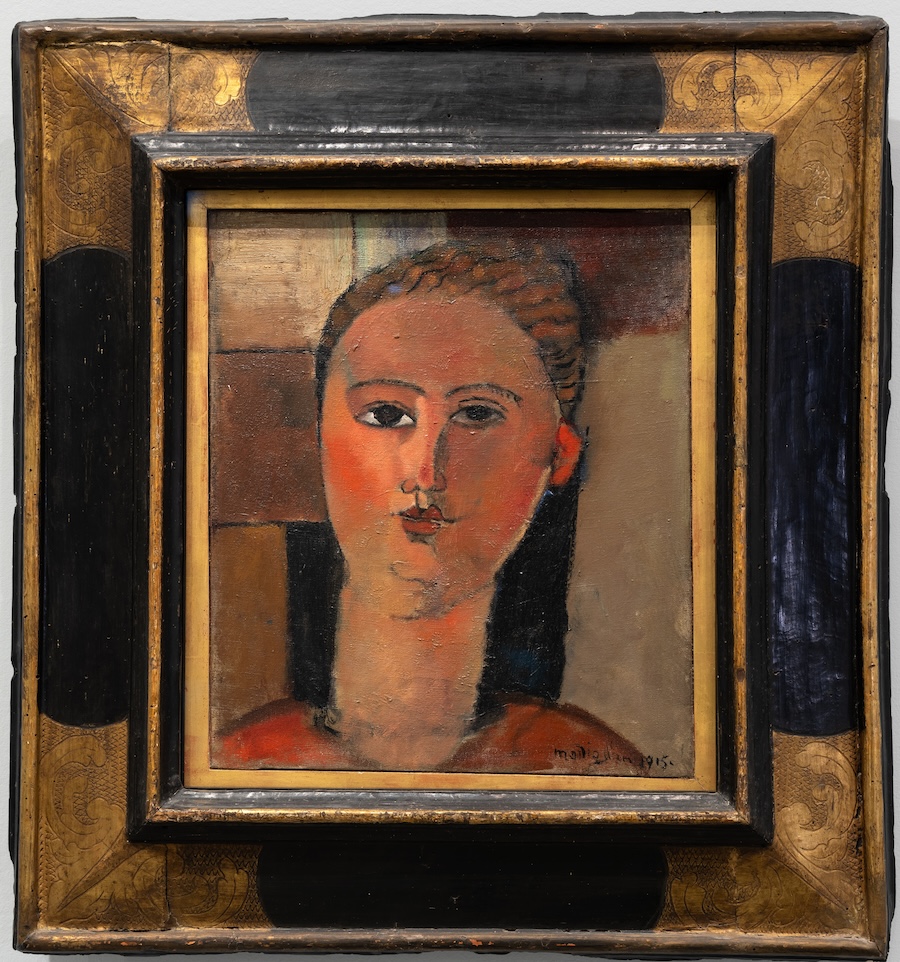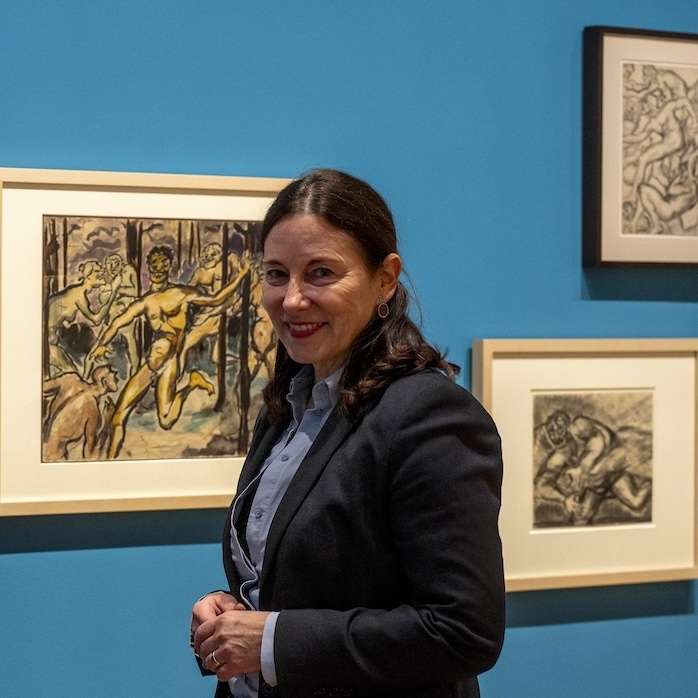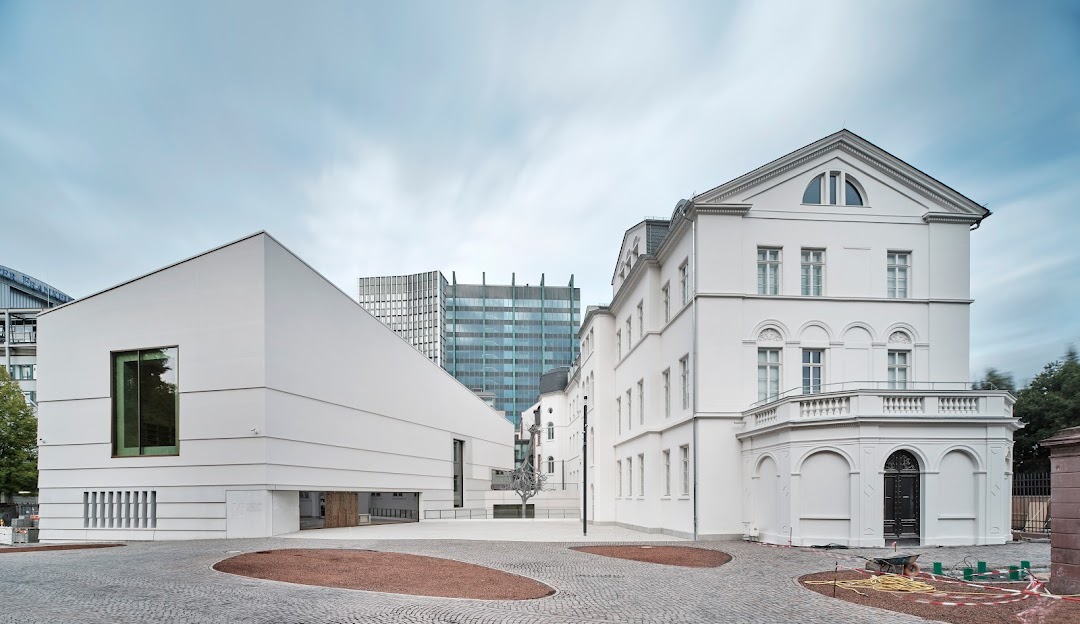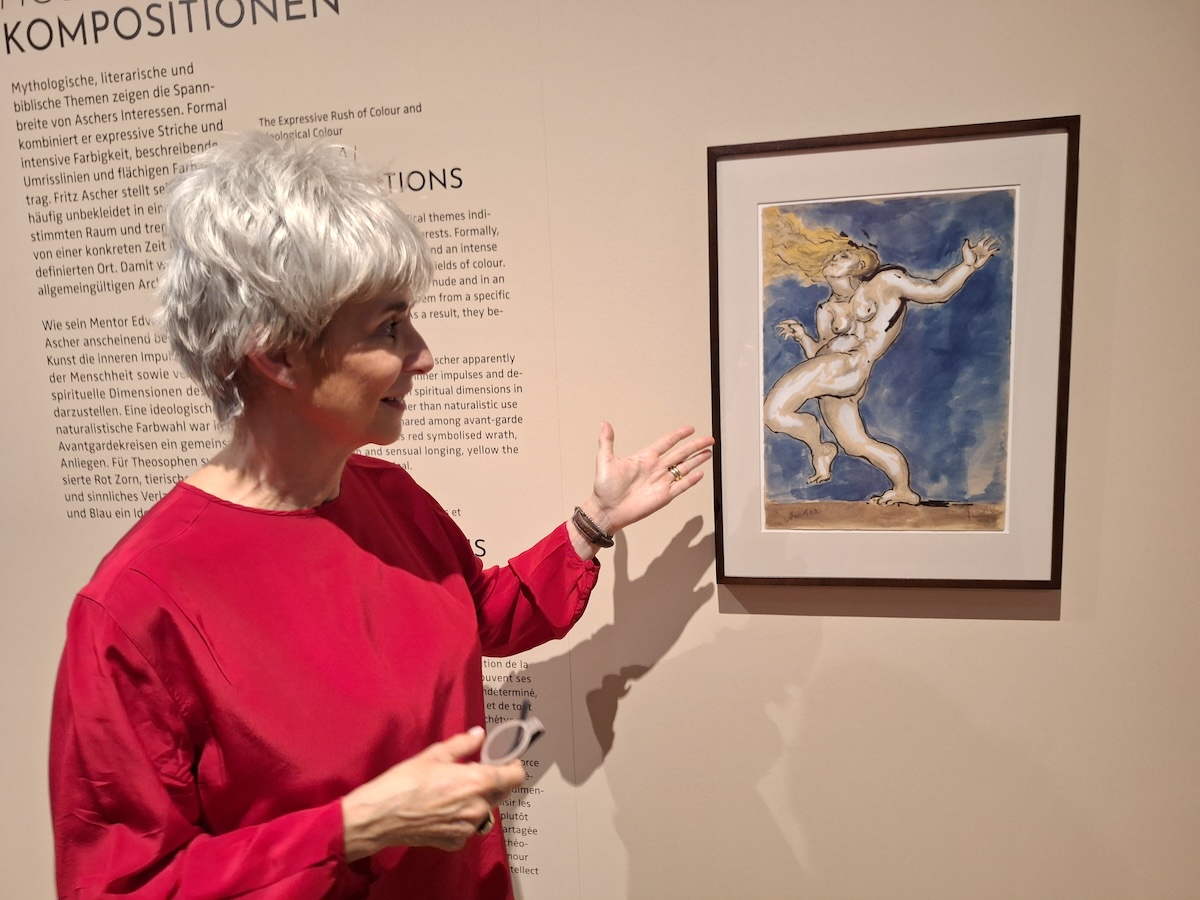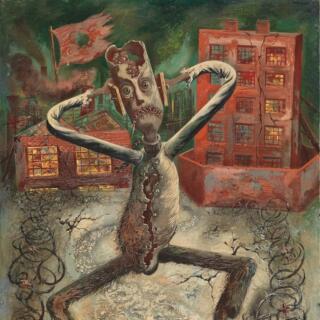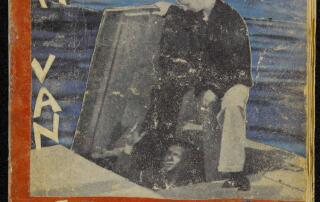Rachel Stern2025-04-09T14:22:41-04:00March 24th, 2025|Events, Lectures, Past Events|
Curator Erik Riedel presents the work of the painter and graphic artist Léo Maillet, who changed his original name Leopold Mayer in exile, reflecting the numerous fractures in his biography. Image above: Léo Maillet, Le Graveur (Self-Portrait), 1944. Oil on cardboard. Permanent loan by the Adolf und Luisa Haeuser-Stiftung für Kunst und Kulturpflege. © estate of Léo Maillet: Daniel Maillet and Nikolaus Mayer After his dramatic escape from a deportation train bound for Auschwitz, Maillet lived in the French Cévennes under a false identity from 1942 onwards. He painted and drew with the simplest of materials. Some years later, he took up the works he had created during his flight and persecution and transformed them [...]
Rachel Stern2025-03-12T14:22:13-04:00March 6th, 2025|Events, Lectures, Past Events|
Georgetown University professor Ori Z Soltes will speak about Ben Shahn (1898-1969), who arrived in 1906 as a child to the United States from Tsarist-governed Lithuania. Four years after the Tsarist authorities had exiled his father to Siberia for alleged revolutionary activities, his mother managed to bring the family to New York. There they reconnected with Ben's father who had escaped from Siberia and made it to the US by way of South Africa. Image above: Ben Shahn, Detail of the Mural "The Meaning of Social Security," Wilbur J. Cohen Federal Building, Washington, D.C. Within 25 years Shahn emerged as perhaps the key figure in the developing arena of American Social [...]
Rachel Stern2025-03-26T16:04:21-04:00February 14th, 2025|Events, Lectures, Past Events|
Journalist and author Michael Sontheimer speaks about Alfred Flechtheim, who was born in 1878 in Münster as the son of a wealthy German Jewish grain dealer. He was trained as a trader but did not want to stay in the family business. As he was fascinated with art, he left his hometown and moved to Düsseldorf, where he opened a gallery in 1913. Image above: Rudolf Großmann, Alfred Flechtheim, 1922-27. Pencil, ink, and gouache on paper, 5.3 x 3.8 in. Museum für Moderne Kunst, Freiburg (Germany) G 62/008 b. After serving in the German Army during the First World War, in 1921 he opened a second gallery in Berlin, the place to be in the 1920s. [...]
Rachel Stern2025-03-02T04:34:45-05:00January 20th, 2025|Events, Lectures, Past Events|
Rachel Stern will present insights into the art and life of the German-Jewish artist Fritz Ascher and the mission of The Fritz Ascher Society for Persecuted, Ostracized and Banned Art. Introduced by Richard Quinlan, Director of the Center for Holocaust and Genocide Education at Saint Elizabeth University in Morristown (NJ). Image above: Fritz Ascher, Male Portrait in Red, c. 1915. Private collection © Bianca Stock Fritz Ascher (1893-1970), a painter, graphic artist, and poet, was recommended to the art academy in Königsberg by the renown German painter Max Liebermann at the age of 16. From 1913 onwards, he gained recognition as a painter in Berlin. Ascher was a keen observer of his era; the [...]
Rachel Stern2025-01-22T13:31:12-05:00December 22nd, 2024|Events, Lectures, Past Events|
Berthe Weill was a trailblazing art dealer who exhibited works by emerging artists in her Parisian gallery from 1901 to 1941. Even though many of them went on to become key avant-garde figures, Weill’s role has been omitted from most historical accounts of 20th-century modernism. In this presentation, Lynn Gumpert, a co-curator of the first exhibition on Weill, provides an overview of this remarkable woman. Image above: Amedeo Modigliani, Fille rousse (Girl with red hair), c. 1915. Oil on canvas, 16 x 14 3/8 in. (40.5 x 36.5 cm). Musée de l’Orangerie, Paris. Jean Walter and Paul Guillame Collection, 1960.46 © Photo: Musée de l’Orangerie / Sophie Crépy Passionate and outspoken, Weill was the [...]
Rachel Stern2024-12-18T05:55:27-05:00December 4th, 2024|Events, Lectures, Past Events|
Jutta Götzmann, exhibition curator of "Love and Betrayal," presents the artist Fritz Ascher (1893-1970) during a tour. In addition to early charcoal, graphite and ink drawings, colorful gouaches are fascinating. Poems that are considered his "unpainted pictures" and were created in secret during the National Socialist era complement the exhibition. BUY TICKETS HERE The Fritz Ascher Society is a not-for-profit 501(c)3 organization. Your donation is fully tax deductible. YOUR SUPPORT MAKES OUR WORK POSSIBLE. THANK YOU. DONATE HERE
Rachel Stern2024-12-18T14:18:11-05:00November 24th, 2024|Events, Lectures, Past Events|
In this book talk, Michael Lambek follows the intertwined history of Mies van der Rohe’s iconic Villa Tugendhat and the family who inhabited it from 1930-1938. Part memoir, part social history, the book traces the family from its origins in a Jewish ghetto to the present day, focussing on the author’s maternal grandmother, Grete Tugendhat who commissioned and championed the house, which is now a World Heritage Site in Brno, Czechia. Image above: Ludwig Mies van der Rohe, Villa Tugendhat, Brno (Czechia), photo David Zidlicky The Villa Tugendhat, designed by Mies van der Rohe in 1929, is an icon of architectural modernism in Brno, Czechia. It was also a family home. [...]
Rachel Stern2024-11-24T14:39:31-05:00October 28th, 2024|Events, Lectures, Past Events|
Der Maler, Grafiker und Dichter Fritz Ascher (1893-1970) wurde bereits als 16-Jähriger von Max Liebermann an die Akademie in Königsberg empfohlen. Ab 1913 gehörte er zu den gefragten Malern in Berlin. Er war ein genauer Beobachter seiner Zeit; die Urkatastrophe des Ersten Weltkriegs und die revolutionären Unruhen in Berlin führten ihn zu christlichen und mystischen Themen, die er radikal neu interpretierte. Nach 1933 erhielt Ascher als Jude Berufsverbot. Während der Pogrome am 9./10. November 1938 wurde er verhaftet und im Konzentrationslager Sachsenhausen und im Potsdamer Gestapo-Gefängnis interniert. Die Schoa überlebte er ab 1942 versteckt in einem Keller in Berlin-Grunewald. Während dieser einsamen Jahre verfasste er Gedichte. Als Künstler fand Ascher nach 1945 seinen ganz eigenen Stil. Angeregt vom nahe [...]
Rachel Stern2024-11-24T14:40:53-05:00October 22nd, 2024|Events, Lectures, Past Events|
Der spätexpressionistische Künstler Fritz Ascher (1893-1970) überlebte zwei Weltkriege und die Verfolgung durch das nationalsozialistische Regime. Als aufmerksamer Beobachter der Schrecken des Ersten Weltkriegs und der revolutionären Unruhen wandte er sich christlich-spirituellen Themen zu, die er radikal neu interpretierte. In intimen Zeichnungen beschäftigte er sich ab 1916 mit dem Thema Liebe und Verrat, sowohl in seiner Auseinandersetzung mit dem Kreuzigungsthema als auch mit der Figur des Bajazzo in der tragikomischen Oper „I Pagliacci“. Kurzvortrag und Führung von Rachel Stern zeigen den Künstler in seinem sozialen und politischen Umfeld. Image above: Fritz Ascher, Im Wald, um 1919. Weisse Gouache und schwarze Tusche über Aquarell und Bleistift auf Papier, 34 x 32,2 cm © Bianca Stock The late expressionist [...]
Rachel Stern2024-07-24T14:45:50-04:00July 2nd, 2024|Events, Lectures, Past Events|
George Grosz (American, b. Germany, 1893–1959) created the “Stick Men” series in Huntington, where he lived from 1947 until shortly before his death. Featuring hollow figures in an apocalyptic landscape, this group of watercolors offers a searing indictment of humanity following World War II, the Holocaust, and the dropping of atomic bombs on Hiroshima and Nagasaki. Grosz was an internationally renowned German-born artist who remained invested in political art following his immigration to the United States in 1933. In the “Stick Men” series, he wrestles with the emergence of Abstract Expressionism and reaffirms the ability of painting to impact society. Image above: Detail of George Grosz (American, b. Germany, 1893–1959), The Grey Man Dances, 1949. Oil on canvas. George [...]
Rachel Stern2024-07-10T16:07:15-04:00June 28th, 2024|Events, Lectures, Past Events|
Under threat from Nazi antisemitism, the young Jewish lawyer Curt Bloch (1908–1975) fled Dortmund for the Netherlands in 1933. He went into hiding there in 1942 and emigrated to the United States after the war. In his hiding place, from August 1943 to April 1945 Bloch produced a magazine with the telling title Het Onderwater Cabaret – “The Underwater Cabaret.” Image above: Curt Bloch, Het Onderwater Cabaret 30 Aug 1943; Jewish Museum Berlin, Convolute/816, Curt Bloch collection, loaned by the Charities Aid Foundation America thanks to the generous support of Curt Blochʼs family Week by week, Curt Bloch created small-format booklets with artfully designed covers, containing a total of 483 handwritten poems in German and [...]
Rachel Stern2024-06-19T14:37:38-04:00June 2nd, 2024|Events, Lectures, Past Events|
Heinz Henghes (1906-1975) was born in Hamburg in 1906, a ‘Mischling’ of mixed Jewish and German descent. In America for almost 10 years before returning to Europe at a time of great political unrest Heinz spent time in Italy where he enjoyed the patronage of Ezra Pound, despite Pounds noted anti-semitism. In London at the outbreak of war Heinz was interned and sent to Australia on the notorious ship the Dunera. Ian Henghes, the artist's son, presents his father’s extraordinary story and the contact he had with other artists, writers and thinkers of his time. Image above: Heinz Henghes in Milan studio ca 1935 © Ian Henghes Ian Henghes is an online communications specialist working [...]






